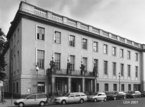Französische Strasse 33D
Richard Paulick
alias Magazin der Staatsoper Unter den LindenFranzösische Strasse 33D, | |
| show on the map |
Important events
People
History
Original name: Magazin der Staatsoper Unter den Linden
Original purpose: scenery and costume depots for Berliner Staatsoper Unter den Linden
Author: Richard Paulick
Construction date: 1951–1954
Style: post-war historicism
Converted to: Academy and Barenboim-Said-Akademie hall, by Frank O. Gehry and HG Merz und rw+
Conversion date: 1965, 2014–2017
Current use: Barenboim-Said-Akademie since 2016; concert hall as from 2017
The Deutsche Staatsoper theatre and the Bebelplatz square, both bombed out during the war, were reconstructed according to plans designed by architect Richard Paulick. In 1952–1954, he designed a building in post-war historicism style to host the theatre’s depots at the site behind the St. Hedwig Cathedral, formerly owned by a banking association. The building hosted rehearsal stages, offices, scenery and costume depots, and is a listed building. In 2002–2008, the opera was experimenting with innovative musical theatre formats and was used as an experimental space for new musical forms. Since the beginning of 2017, the premises have been rented and used by the famous Barenboim-Said-Akademie music academy at a symbolic rent of 1 euro per year for a minimum period of 99 years.
Note. Barenboim-Said-Akademie renders support to the peace-promoting musical project known as the West-Eastern Divan Orchestra that was founded in 1999 in Weimar, Germany, by the celebrated Argentinian-Israeli-Spanish pianist and conductor Daniel Barenboim (formerly the chief conductor of the La Scala opera house in Milan; since 1992 the chief conductor of Deutsche Staatsoper) and Palestinian-American professor of literature Edward W. Said. The orchestra consists of an equal number of Israeli and Arab musicians and has been making headlines worldwide ever since it was established. The orchestra is aiming to demonstrate that peaceful coexistence – regardless of nationality or religious denomination – is not a utopia.
As its latest project the Academy has launched a unique music academy where students from Israel and Arab countries will not only obtain musical education but also read philosophy, history and literature. The school’s mission is to raise musicians educated in humanities and holding humanistic values who are capable of listening to each other – and thereby to become a symbol of reconciliation.
The overall reconstruction was designed by the Berlin architectural studio of HG Merz und rw+. The building hosts a music academy for students from Israel and Arab countries, 21 rehearsal stages, one large auditorium, a foyer with a café, and a concert hall designed by American architect Frank Gehry completely for free as a gesture of support for the project. The space has been named after the recently diseased iconic conductor Pierre Boulezo (1925–2016). The shape of the hall is constituted by two merging ovals symbolizing the concept of connection. Walls and ceilings are panelled with light wood and the space is lit by daylight. The concert hall has 620 seats none of which is more than 14 meters away from the conductor. Acoustics has been taken care of by the Japanese acoustics guru Yasuhisa Toyota.
The school opened in September 2016 and the concert hall opening ceremony took place on March 3, 2017. The project is predominantly funded by German ministries, private donors and sponsors. Further income comes from guided tours at the construction site.
Author: Marcela Steinbachová
Marcela Steinbachová:
Semperdepot, La Fenice Theatre Scenic Shops, Teatro alla Scala Theatre Scenic Shops, Teatro di San Carlo Scenic Shops, Rehearsal Stages and Admin Offices, Teatro Regio Scenic Shops in Parma, Teatro dell'opera di Roma Scenic Shops, am Wriezener Bahnhof, Französische Strasse 33D, Französische Strasse 30, Chauseestrasse 28, Zehdenicker Strasse, Newport Street, The Cut, South Bank, Purfleet, Theatre Depots and Scenic Shops, Arsenal, The Royal Provincial German Theatre scenic shop, Apolinář, Divadelní Street, Flóra, Korunní, PreslovaTranslator: Jiří Pilucha
Jiří Pilucha:
Semperdepot, La Fenice Theatre Scenic Shops, Teatro alla Scala Theatre Scenic Shops, Teatro di San Carlo Scenic Shops, Rehearsal Stages and Admin Offices, Teatro Regio Scenic Shops in Parma, Teatro dell'opera di Roma Scenic Shops, am Wriezener Bahnhof, Französische Strasse 33D, Französische Strasse 30, Chauseestrasse 28, Zehdenicker Strasse, Newport Street, The Cut, South Bank, Purfleet, Theatre Depots and Scenic Shops, Arsenal, The Royal Provincial German Theatre scenic shop, Apolinář, Divadelní Street, Flóra, Korunní, PreslovaAdditional information
No information has yet been entered
Add information





